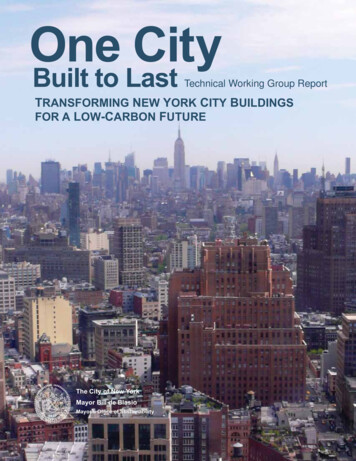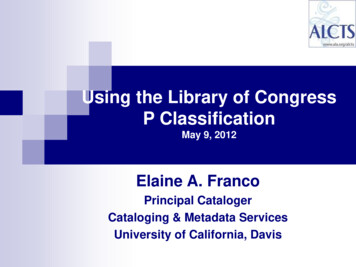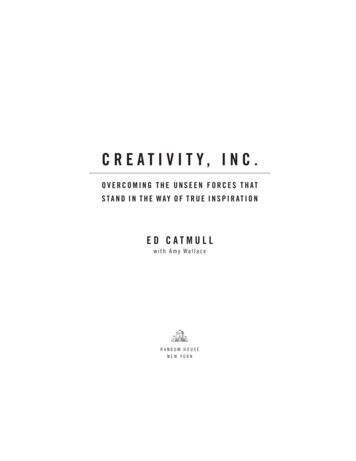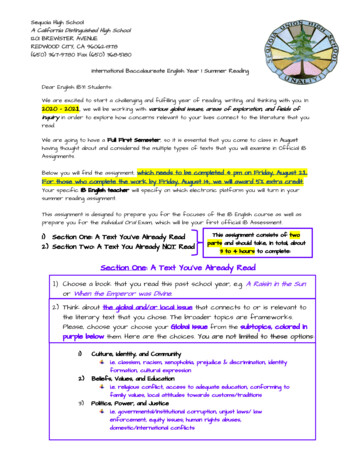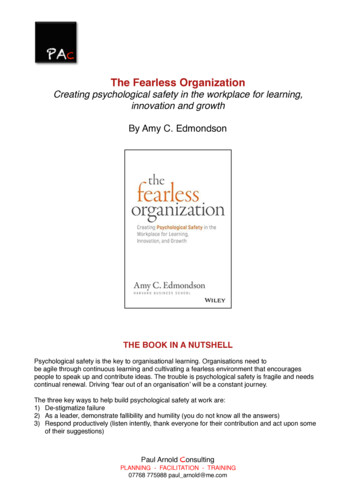
Transcription
The Fearless OrganizationCreating psychological safety in the workplace for learning,innovation and growthBy Amy C. EdmondsonTHE BOOK IN A NUTSHELLPsychological safety is the key to organisational learning. Organisations need tobe agile through continuous learning and cultivating a fearless environment that encouragespeople to speak up and contribute ideas. The trouble is psychological safety is fragile and needscontinual renewal. Driving ‘fear out of an organisation’ will be a constant journey.The three key ways to help build psychological safety at work are:1) De-stigmatize failure2) As a leader, demonstrate fallibility and humility (you do not know all the answers)3) Respond productively (listen intently, thank everyone for their contribution and act upon someof their suggestions)Paul Arnold ConsultingPLANNING - FACILITATION - TRAINING07768 775988 paul arnold@me.com
THE BOOKTHE PROBLEM“No passion so effectively robs the mind of all its powers as fear” - Edmund BurkeWith the increasingly volatile, uncertain, complex and ambiguous (VUCA) world we live in, it’s evenmore important to fully utilise the latent potential of the workforce (to find solutions to increasinglychallenging problems). We need teamwork where knowledge is freely shared across theorganization. If the culture makes people afraid to share kes/knowledge, then everyone loses. Our workplace is moving much more incollaboration (both inside an organisation, across geographical boundaries as well as with externalorganisations - 50% more time is spent collaborating than 20 years ago). Nearly every decision inan organization these days is made from seeking multiple perspectives from others. The greater anissue is analysed, then it is more likely the organization will make a better decision. So if we workin an environment that unconsciously suppresses expression, then we are more likely to makesub-optimal (and potentially catastrophic) decisions.It’s an old truism that bad news does not travel up the hierarchy. The trouble is in today’s hecticworkplace, there is little time or desire to entertain ‘blocks or challenges’. It steals time and energy.Managers MUST deliver! Furthermore, certain metrics (like faults) are closely monitored so thesenumbers can get ‘massaged’. So unconsciously even when raised managers will tend to nod andthen squash or ignore.Sadly research also suggests psychological safety is in short supply in many organisations thesedays. There appears to be an epidemic of silence, where people are afraid of the consequences ofspeaking up and out - even when they recognise what they wanted to say would be of importancefor the organisation (and this can sometimes lead to stress and personal regret).When quizzed people say they did not want to be seen in a bad light or damage relationshipswhilst others expressed the perceived futility of speaking up (i.e. high risk, low reward). Typicalareas they wanted to comment on were poor performance of a manager, harassment, orsuggested improvements for work processes.In one piece of research, 85% of respondents reported that on at least one occasion at work theydid not feel they could raise an important concern with their boss. Even senior people can still feelthe pressure not to comment or challenge.Research highlighted some of the ‘taboo’ transgressions you do not commit:Don’t criticise the boss on something s/he was involved in creatingDon’t speak unless you have solid dataDon’t speak if your boss’s boss is presentDon’t speak up in a group which could make your boss lose faceThe reality is, keeping quiet is usually always the safer option and consequently is the defaultsetting (no-one gets fired for silence) - whilst speaking up has high perceived risk. The trouble isbecause people do not speak up its impact is hidden from research. We do not know the realimpact of silence.Paul Arnold ConsultingPLANNING - FACILITATION - TRAINING07768 775988 paul arnold@me.com
Sadly, many managers still believe ruling through fear is an effective way to maximiseperformance. Yet research has clearly demonstrated that fear inhibits learning and co-operation.Fear diverts resources to manage this perceived threat, including reducing working memory. Thisimpairs analytical thinking, creativity and problem solving abilities.‘Workarounds’ is a term defined by Anita Tucker when she observed nurses. She noticed thatrather than challenge the bosses, they found ways around the problem. Workarounds are oftenless efficient and essentially hide the underlying problem. Teams with low psychological safety tendto indulge more in walkarounds. Research has shown projects with greater psychological safetywere more successful overall than ones with low psychological safety. This in turn led to greaterfinancial return.WHAT IS PSYCHOLOGICAL SAFETY?The fearless organization is one where interpersonal fear is minimised, allowing a freer flow ofknowledge. It’s an environment where a person feels able to express their views on somethingopenly and honestly without fear of recrimination, abuse, putdown or humiliation.Julia Rovovsky led a major, multi-year study of team effectiveness at Google (Project Aristotle).They analysed many different factors they thought may explain why some teams were moresuccessful than others (these included education, hobbies, personality traits, backgrounds etc).They found no correlating features. What they eventually found was psychological safety was thekey factor that led to high performing teams. This was supported by four other features:1) Clear goals2) Dependable colleagues3) Personally meaningful work4) Belief that the work has impactPsychological safety is not about being nice. It’s about being able to speak the truth. And it’s okayto disagree. Nor is psychological safety about lowering standards. It is actually the opposite. It’sabout creating an environment that allows people to be more honest: to challenge, makeimprovement suggestions - that critically gets acted upon.Psychological safety appears to live at the group/team level. In any organisation you will findpockets of both high and low psychological safety (often linked to the leader in that area).Psychological safety starts at the top (but everyone’s also responsible for it).Paul Arnold ConsultingPLANNING - FACILITATION - TRAINING07768 775988 paul arnold@me.com
BENEFITSThe benefits of psychological safety are huge and widespread.Research has shown psychological safety helps boost engagement/fulfilment/greater meaning,and so helps unleash the talent of the workforce. It increases personal growth, team building,learning/new insights, error reporting, knowledge sharing, and creativity. It also helps reduce workstress, sick days, turnover, and helps overcome interpersonal challenges (such as geographicdispersement, conflict as well as embracing ethnic diversity). Ultimately, it leads to increasedproject effectiveness, innovation, in market competitiveness and financial return.REAL LIFE EXAMPLESThere have been many reported cases of people failing to challenge authority, leading to majormistakes (be it on planes, in companies, in hospitals etc). Unreachable targets matched withcommand and control management structures seems to be at the heart of other corporatedisasters such as VW and Wells Fargo (to name but two).VW - In the VW emissions scandal over 50 people were found to be knowingly involvedin a deliberate conspiracy to defraud the USA Environmental Protection Agency. 11mdiesel cars around the world had the software that meant when tested, it would record asignificantly lower level of Nitrous Oxide. It all started to go wrong with the highlyambitious CARB (California Air Resources Board). Such was the pressure both in thepublic arena and inside the organisation, that the NOx levels had to be hit - no question.The CEO, Martin Winterkorn was known to be a tough, impatient, arrogant man with anobsessive focus of detail and perfectionism. If one presented bad news to him, he wouldshout and demean the individual in front of others. We find such behaviours often deeplyengrained in an organisation’s history. Winterkorn, for example, was a protege of theprevious boss, Ferdinand Piech. Piech instigated a reign of terror and a culture drivenby fear and intimidation. Motivation through fear is effective at driving short termperformance but not long term (as it disempowers the workforce’s latent potential).WELLS FARGO - Wells Fargo was regarded as one of the most valuable banks in theUSA, servicing over a third of the US population. With the incessant pressure to grow, itdecided it could gain a competitive advantage by becoming a one stop shop for all itscustomers’ financial needs. In the early 2000s, they adopted a cross selling strategythey called ‘Going for Gr-Eight’ (i.e. to take the average number of financial productsheld by an individual up from 6 to 8). Very aggressive targets were set for everyone.Each branch had to report their sales four times a day. If they did not hit their targetsthey were fired. One area president told his people to “do whatever it takes to sell”. Thispressure of targets and fear of dismissal led to over two million fake accounts beingcreated, as well as lying to customers to say that certain products were only available ifpurchased with others. By September 2016, they were found guilty of widespreadmisconduct, and were fined 185m.Both companies were filled with talented people. But lack of psychological safety stoppedthem from facing the realities of the environment they were in. The seeds of failure weresown many years before by the culture of the organization. If the truth can’t be told (or notPaul Arnold ConsultingPLANNING - FACILITATION - TRAINING07768 775988 paul arnold@me.com
heard) then eventually the senior management will start making fatal decisions based onfalse information.Dangerous Silence - examples of how lack of psychological safety has caused major issues:COLUMBIA - On Feb 1 2003, Columbia suffered a catastrophic re-entry into the earth’satmosphere, killing all seven astronauts. Two weeks earlier, at the launch, one of theengineers, Rodney Rocha, thought he saw a chunk of insulating foam fall off the tankand strike the left wing. Rocha wanted to get satellite footage to check damage but thisrequest was denied. He did not challenge it. Later on when asked why not, he said hewas too low down in the organisation and the person who denied the request was “wayup here”CANARY ISLAND PLANE CRASH - In March 1977 two Boeing 747 collided with eachother on a runway in the Canary Isles, killing 583 people. The runway was covered infog so neither plane could see each other. Even with their own lives at risk, the firstofficer and chief engineer did not feel able to continue to challenge their dogmatic andimpatient captain, Jacob Van Zanten.CHALLENGER - The 1986 Challenger explosion, Roger Boisjoly, an engineer atcontractor Morton-Thiokol, raised his concern the night before launch that the O-ringscould be a faulty design. Due to the pressure to launch, his concerns were squashed.UBER - In April 2017, Susan Fowler wrote a 3000 word blog about her own harassmentfrom a male colleague at work. Uber at the time tried to squash it, saying it was thisman’s first ever offence and he would be given a stern talking to (as he was a highperformer). Uber’s cultural value of ‘super-pumpedness’ did not support psychologicalsafety. It took until June 2017 for the issue to snowball before the CEO stepped down.The fearless workplace - real examples of psychological safety at work:PIXAR - Pixar became one of the most successful studios because it putpsychological safety at the core of its processes. Co-founder Ed Catmull said candourwas critical to ensure high production standards were maintained. During thedevelopment period of a film, a group (The Braintrust) get together to review theprogress of the film. These people are encouraged not to hold back but speak theirmind. There are some clear rules of The Braintrust to ensure it stays on track:-Feedback must be constructive-The filmmaker cannot be defensive or take comments personally-The comments are suggestions not mandates-Feedback is not a ‘Gotcha’ but to come from a place of empathy and positiveintent for the film. It is because they respect and trust in each other that this canwork. Thus praise is also given out in equal measure.Failure is another key ingredient for Pixar’s success. They embrace - even celebrateit. They see it as an essential ingredient for creativity. They claim creativity is a bit likeriding a bike; you never get it right first time. Failure is key way we learn and grow.Thus people must be given the freedom to fail. If they are not, then people will tendnot to take risks and continue what was done before, so will not explore new territories(not doing what’s done in the past is a key concept in creativity). With a fear driven/riskminimising culture all work would be derivative not innovative. Catmull therefore triesto decouple failure from fear.Paul Arnold ConsultingPLANNING - FACILITATION - TRAINING07768 775988 paul arnold@me.com
EILEEN FISHER - Eileen Fisher, owner of the eponymous clothes retailer practices “Idon’t know” (Likewise, Anne Mulcahy, CEO at Xerox ). It’s too easy to be sucked in bythe aura of being the ‘all knowing, all powerful boss’. She believes she needs todemonstrate that even the person at the top of a company does not have all theanswers (thus exposing her fallibility and hence vulnerability). You must demonstratehumility and vulnerability to open the doors for other people’s contribution. She insteadpractices active listening. These two traits encourages others in the organisation tocome forward with ideas.GOOGLE X - Google set up Google X, an innovations lab, to develop ‘Moonshottechnologies that would make the world a better place’. They positively reward (withbonuses and promotions) the closing down of projects so they do not waste resourcepursuing dud projects (allowing them instead to invest in projects with greaterpotential).Rapid Evaluation - GoogleX operates through a process of ‘disciplinedexperimentation’. Just as scientists must try to disprove their hypotheses (in order tovalidate them), so does Google X. They actively seek to test their ideas to destruction.The team first starts with Stage1: a ‘Pre-Mortem’ - a brainstorm to try to define asmany reasons why the project could fail. Then a project moves into Stage 2: RapidEvaluation.This stage involves making quick and simple prototypes. If it passes thisstage then Step 3 is The Foundry - where a team challenges the need of the product(Should the solution exist? Will people actually use it?). Since 2016, the companyhave held an annual convention where they showcase their failures.MINING - Cynthia Carroll was the first female CEO appointed to run an internationalmining company. When she took over, one of her key objectives was to reducefatalities/serious injuries to zero from an average of 40 per year (an almost impossibletask bearing in mind the inherent danger of mining). To demonstrate her intent, sheimmediately shut down one of the most dangerous mines (costing the company 8m aday). She wanted to hear from the miners herself what the problems were and how toresolve them. Due to past culture, miners were reluctant to speak up, so sheinstigated a traditional South African tradition of lekgotla (village meetings). Everyonesits in a circle and has the chance to speak without being criticised or interrupted.They shifted the key question away from safety to “What do we need to do to createan environment of care and respect?’. This led to a wide range of incrementalimprovements that generated increased trust between workers and the management.Both sides then signed a contract outlining what both management and workers woulddo to create this improved environment. 30,000 workers were re-trained. Regularsafety reviews were conducted. Safety metrics were institutionalised. Fatalities did notreach zero but did drop to 17 (with each death fully honoured). Although productionand revenues fell following the mine’s closure, by 2011 the company had achieved thehighest operating profits in its long history. Moving to a place of mutual trust had notjust saved lives but increased productivity.P&G - In his book, The Game Changer, AF Laffley, ex-CEO of P&G, lists his 11 mostexpensive failures, citing these as excellent examples of corporate learnings.Paul Arnold ConsultingPLANNING - FACILITATION - TRAINING07768 775988 paul arnold@me.com
WAYS TO IMPROVE PSYCHOLOGICAL SAFETYYou can tell whether a man is wise by his questions - Naguib MahfouzPsychological safety is built from trust and respect across an organisation. There are three keyactions a leader needs to undertake to initiate the shift in culture:1) De-stigmatise failure - The leader needs to state up-front that failure is acceptable (Catmull atPixar reminds people at the start of a new film that it always starts out bad before cominggood).In a piece of research, the authors asked ‘What percentage of work that goes wrong isblameworthy?’ The answers tend to be in the low single digits. But when asked, ‘Whatpercentage of failures ARE treated as blameworthy?’ - the response is usually between70-90%. This mis-apportion of blame (blame-skating) leads people to be defensive and notadmit to personal mistakes (as the history of the company has shown such admissions can bepersonally costly). Clearly breaches of standards/morals must be swiftly reprimanded, butthese have been shown to increase psychological safety rather then decrease it.They also need to emphasise the purpose of the organisation and what is at stake. Subtleshifts in language can help play a key role e.g. replacing ‘error’ with ‘accident’.2) Demonstrate fallibility and humility - It is key for the leader to demonstrate humility - to admitthey do not know all the answers (and instead invite the team to make suggestions - especiallythose with hands-on experience). Otherwise people will be resistant to proffer ideas if the bossappears to project an aura of ‘knowing it all’. They need to actively invite others to contribute.They also need to develop the art of good questioning and even more importantly, the skill ofactive listening.3) Respond productively - To build trust one must do more than just listen. How you respond iscritical. For example, simply thanking them (genuinely) for their contribution helps encouragefuture contributions. You need to also act - e.g. by doing some of the suggestions, celebratingfailure (and stopping activities that destroy psychological safety).But it is not just the leaders who can help build and maintain a psychologically safe environment.Studies have revealed where there is a lot of communication across co-workers in a team, itincreases trust, friendship and hence psychological safety.Perhaps the easiest way to develop psychological safety is to act as if it already exists. Everyperson in an organisation is able to influence and direct psychological safety.Furthermore, little snipes and gestures can easily erode the atmosphere of trust. And these can becommented upon by anyone in the organisation. Frances Frei from Harvard suggests saying,“Wow that felt super-inappropriate. Can we have a do-over?”Paul Arnold ConsultingPLANNING - FACILITATION - TRAINING07768 775988 paul arnold@me.com
CRITIQUEThis book is a pretty dry read. Whilst the case histories are compulsive reading, they are a bit toofar removed from the experience of most of us in our everyday worlds.It’s also quite an academic book, referencing many other pieces of research to help support theirown conclusions.Furthermore, it is a bit rambly. As often is the case with these business books, it’s one key themeover-written to pad out 200 pages.The biggest issue I have with the book is its heavy on the issue but far too light on the practicalanswers to this deeply embedded problem.Finally a word of caution. Psychological safety is not the magic elixir that will solve all theorganisation’s issues. You still need all the other leadership tools such as objective setting, metricsetc.Paul Arnold ConsultingPLANNING - FACILITATION - TRAINING07768 775988 paul arnold@me.com
An unashamed plug for my services!A nudge aheadof the curveAll you need to know aboutBehaviouralEconomicsto stay ahead of the competitionThe workshop facilitates the brainstorming of potentialapplications to the delegate’s brands based on a number ofkey principles.Thus everyone who attends will walk away with tangibleapplications to their brands the very next day.Paul Arnold ConsultingPLANNING - FACILITATION - TRAINING07768 775988 paul arnold@me.com
areas they wanted to comment on were poor performance of a manager, harassment, or suggested improvements for work processes. In one piece of research, 85% of respondents reported that on at least one occasion at work they did not feel they could raise an important c

